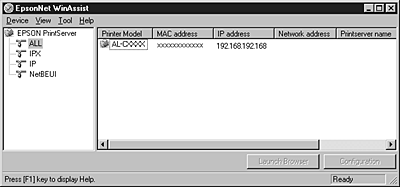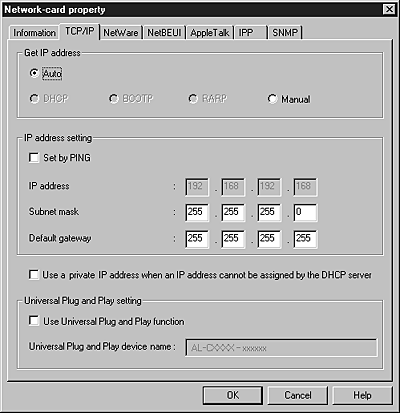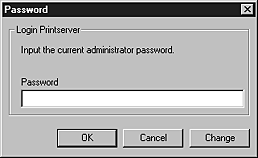|

Administrator's Guide
|
|
Configuring the Internal Print Server / EpsonNet WinAssist Configuration Utility
Configuring Your Printer Using EpsonNet WinAssist
 About passwords
About passwords
This section explains how to use EpsonNet WinAssist to set an IP address for the Internal Print Server.
 |
Note:
|
 | -
If you are using the printer in a dial-up environment not running NetWare, clear the use NetWare check box on the NetWare screen. If this check box is selected, the extra account may be charged when you use the dial-up router.
|
|
 | -
When configuring the Internal Print Server for NetWare, use the IPX protocol and log in to the NetWare server or the NDS context with supervisor privileges.
|
|
 | -
When you configure the Internal Print Server for NetWare 5.x, you must log in to the NetWare server using an IPX connection. If you log in to the NetWare server using an IP connection, the NetWare screen and the IPX trap setting of SNMP are not available.
|
|
Follow the steps below to set the IP address. The sample screens are taken from Windows 95 using EpsonNet WinAssist. Other systems differ in appearance, but the instructions are the same, except as noted.
 |
Check that the necessary protocols are installed on the computer.
|
 |
Turn on your printer.
|
 |
Start EpsonNet WinAssist.
|
For Windows Me/98/95/2000/NT 4.0:
Click Start, point to Programs, and then select EpsonNet WinAssist. Click EpsonNet WinAssist.
For Windows NT 3.51:
Double-click the EpsonNet WinAssist icon in the EpsonNet WinAssist group.
 |
Select All or your preferred protocol on the left side of screen.
|
 |
Select the printer you want to configure, and then click Configuration or double-click the printer icon.
|

 |  |
Note:
|
 |  | -
If the same printer model name appears multiple times in the list, you can distinguish the printers by their MAC address, which are found on a network status sheet.
|
|
 |  | -
You can search printers in other segments by setting the Search Options from the Tool menu. See Search options for more information.
|
|
 |  | -
The Launch Browser button can be used only if a valid IP address is assigned to the printer.
|
|
 |
Click the TCP/IP tab to display the TCP/IP menu.
|
 |  |
Note:
|

 |
Select the "Get IP address" method. If you select Auto, DHCP becomes available and assigns an IP address automatically. If you select Manual, you can enter the IP address manually.
|
 |  |
Note:
|
 |  | -
The default is Auto. When Auto is selected, DHCP becomes available. To use the DHCP server, make sure it is installed on your computer and configured correctly. See your operating system's online help for detailed instructions.
|
|
 |  | -
If Auto is selected but no DHCP server is installed in your system or on your network and the Use a private IP address when an IP address cannot be assigned by the DHCP server check box is cleared, the Internal Print Server uses "192.168.192.168" as the default IP address.
|
|
 |  | -
If Auto is selected for Get IP address, every time you turn on the printer you need to change the printer port setting accordingly. Therefore, for TCP/IP printing we recommend selecting Manual and setting the IP address manually.
|
|
 |
When setting the IP address using the ping command, select Manual and then select the Set by PING check box.
|
 |  |
Note:
|
 |  | |
Be sure to clear the check box when not using ping; this prevents any unexpected change of the IP address by EpsonNet WebManager.
|
|
 |
When you select Manual, assign the IP address, the subnet mask, and the default gateway. Be sure to give an IP address that does not conflict with any other device on the network.
|
 |  |
Note:
|
 |  | -
The default value for the IP address, subnet mask, and default gateway are 192.168.192.168, 255.255.255.0, and 255.255.255.255 respectively.
|
|
 |  | -
If there is a server or a router which functions as a gateway, enter the IP address of the server or the router for the gateway address. If there is no gateway, leave the default values there.
|
|
 |
Select the Use a private IP address when an IP address cannot be assigned by the DHCP server check box to get a private address between 169.254.1.1 and 169.254.254.254 automatically when an IP address cannot be obtained by the DHCP server.
|
 |
Select the Universal Plug and Play function check box if you want to use the Universal Plug and Play function in Windows Me or future operating systems. Change the default Universal Plug and Play device name, if desired. This device name is used for Windows that supports the Universal Plug and Play function.
|
 |
After changing the settings, click OK. The Password dialog box appears.
|
 |
Enter your password (up to 20 characters) and then click OK to save the settings. If you are entering a password for the first time, click Change and set the password. For more information on passwords, see About passwords.
|
Follow the on-screen instructions. After the update is complete, refresh the configuration by selecting Refresh from the View menu.
 |  |
Caution:
|
 |  | |
Since it takes 2 or 3 minutes to send new settings to the Internal Print Server, wait until an on-screen message appears to indicates that you can turn off your printer.
|
|
Print a network status sheet to confirm the new IP address.
About passwords
A password is required to configure the Internal Print Server. When you click OK in the setting dialog box or click the Return to default button, the Password dialog box appears.
 |
To set a password or to change the current password, click Change.
|

 |
In the Administrator password dialog box, enter a password (up to 20 characters) and click OK. Passwords are case sensitive.
|
 |  |
Note:
|
 |  | -
The same password is used for EpsonNet WinAssist, MacAssist, and WebAssist.
|
|
 |  | -
Since the new password becomes effective after sending the data to the Internal Print Server, enter the old password immediately after changing the password.
|
|
 |  | -
If you forget your password, you need to initialize the Internal Print Server. See Initializing Your Printer for instructions.
|
|

[Top]
| Version 1.00E, Copyright © 2002, SEIKO EPSON CORPORATION |
About passwords